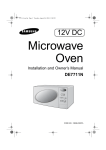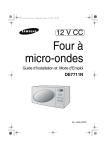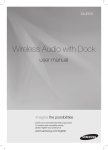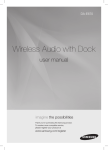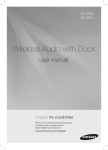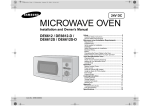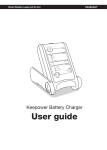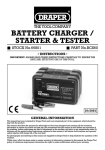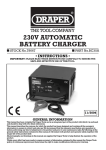Download Samsung DE7711 Owner`s manual
Transcript
7711-Cover.auto.fm Page 1 Tuesday, August 24, 2004 1:46 PM 12V DC Microwave Oven Installation and Owner’s Manual DE7711N DE7711 CODE NO. : DE68-03008A 7711-Safety.auto.fm Page 2 Tuesday, August 24, 2004 1:46 PM SAFETY PRECAUTIONS TO AVOID POSSIBLE EXPOSURE TO EXCESSIVE MICROWAVE ENERGY: (a) Do not attempt to operate this oven with the door open since open-door operation can result in harmful exposure to microwave energy. It is important not to defeat or tamper with the safety interlocks. (b) Do not place any object between the front face of the oven and the door or allow soil or cleaner residue to accumulate on sealing surfaces. (c) Do not operate the oven if it is damaged. It is particularly important that the oven door close properly and that there is no damage to the 1) Door (bent or dented), 2) Hinges and latches (broken or loosened), 3) Door seals and sealing surfaces. (d) The oven should not be adjusted or repaired by anyone except properly qualified service personnel. IMPORTANT SAFETY INSTRUCTIONS When using any electrical appliance, basic safety precautions should be followed, including the following: WARNING To reduce risk of burns, electric shock, fire, personal injury or exposure to excessive microwave energy: • • • • • • WARNING Always observe Safety Precautions when using your oven. Never try to repair the oven on your own – there is dangerous voltage inside. If the oven needs to be repaired, call SAMSUNG- for the name of an authorized service center near you. • Read all safety instructions before using the appliance. Read and follow the specific “Precautions to avoid exposure to excessive microwave energy” on this page. Install or place this appliance only in accordance with the installation instructions provided. Some items, like whole eggs and food in sealed containers, may explode if heated in this oven. Use this appliance only for its intended use as described in the manual. Do not use corrosive chemicals or vapors in this appliance. This type of oven is specifically designed to heat, cook, or dry food. It is not designed for industrial or laboratory use. IMPORTANT SAFETY INSTRUCTIONS During cooking, you should look into the oven from time to time when food is being heated or cooked in disposable containers of plastic, paper or other combustible materials. IMPORTANT Young children should NEVER be allowed to use or play with the microwave oven. Nor should they be left unattended near the microwave oven when it is in use. Items of interest to children should not be stored or hidden just above the oven. SAVE THESE INSTRUCTIONS 2 SAFETY 7711-Safety.auto.fm Page 3 Tuesday, August 24, 2004 1:46 PM SAFETY Important Safety Instructions, continued • • • • • • • • • • • • • Do not operate this appliance if it has a damaged Power cable, if it is not working properly, or if it has been damaged or dropped. This appliance should be serviced only by qualified service personnel. Contact the nearest authorized service facility for examination, repair, or adjustment. Do not cover or block any of the openings on this appliance. Do not store this appliance outdoors. Do not use near water – for example, near a kitchen sink, in a wet basement, or near a swimming pool, etc. Keep the inside of the oven clean. Food particles or spattered oils stuck to the oven walls or floor can cause paint damage and reduce the efficiency of the oven. Do not immerse power cable in water. Keep power cable away from heated surfaces. When cleaning door and oven surfaces, use only mild, nonabrasive soaps or detergents applied with a sponge or soft cloth. To reduce the risk of fire in the oven: a. Do not overcook food. Watch appliance carefully if paper, plastic, or other combustible materials are inside. b. Remove wire twist-ties from paper or plastic cooking bags before placing bags in oven. c. Do not use the oven compartment for storage purposes. Do not leave paper products, cooking utensils, or food in the oven when not in use. Do not try to preheat oven or operate while empty. Do not cook without the glass tray in place on the oven floor. Food will not cook properly without the tray. Do not defrost frozen beverages in narrow necked bottles. The containers can break. Dishes and containers can become hot. Handle with care. • • • • • • Carefully remove container coverings, directing steam away from hands and face. Do not operate any other heating or cooking appliance beneath appliance. Do not mount unit over or near any portion of a heating or cooking appliance. DO NOT use any metallic cookware in the microwave oven: - Metallic containers - Dinnerware with gold or silver trimmings - Skewers, forks, etc. DO NOT heat: Airtight or vacuum-sealed bottles, jars, containers Ex) Baby food jars Airtight food. Ex) Eggs, nuts in shells, tomatoes Take particular care when heating liquids and baby foods. - ALWAYS allow a standing time of at least 20 seconds after the oven has been switched off so that the temperature can equalize. - Stir during heating, if necessary, and ALWAYS stir after heating. - Take care when handling the container after heating. You may burn yourself, if the container is too hot. - A risk of delayed eruptive bolling exists. To prevent delayed boiling and possible scalding, you should put a plastic spoon or glass stick into the beverages and stir before, during and after heating. - NEVER fill the container to the top and choose a container that is wider at the top than at the bottom to prevent the liquid from boiling over. Bottles with narrow necks may also explode if overheated. - ALWAYS check the temperature of baby food or milk before giving it to the baby. - NEVER heat a baby's bottle with the teat on, as the bottle may explode if overheated. SAVE THESE INSTRUCTIONS SAFETY 3 7711-Safety.auto.fm Page 4 Tuesday, August 24, 2004 1:46 PM SAFETY WARNING Safety Requirements: If safety requirements are not followed, it may result in an injury or a damage to the appliance. General Safety Requirements • • Precaution! Safety Requirements If safety requirements are not followed, it may result in a damage to the appliance or malfunction. Read the Owner’s Manual carefully before using the microwave oven. The Owner’s Manual includes valuable information necessary not only for your safety, but also for appliance maintenance. • • • • • • • If the oven is not going to be in use for a long period of time, disconnect it and store it in a cool, well ventilated place. If the oven is going to be used and stored by another person, be sure to include the Owner’s Manual along with the microwave oven. This appliance is equipped with a capacitor. Therefore, when relocating the oven, be sure to first disconnect the battery, wait 20 seconds, then disconnect the power cable connections. Do not operate the oven if it does not work properly. Be sure to disconnect the battery from the oven to prevent an injury or damage to the appliance. The oven is only for cooking or boiling. Only qualified service personnel trained specifically by the manufacturer should repair this appliance. Do not attempt to repair the oven yourself. Keep the oven out of the reach of children. When installing the oven in a vehicle, ask a installation specialist for help. SAVE THESE INSTRUCTIONS 4 SAFETY 7711-body.auto.fm Page 5 Tuesday, August 24, 2004 1:52 PM CONTENTS Microwave Oven Installation Requirements .................................... 6 Requirements ................................................ 6 Supplied Items ............................................. 6 Items needed for Installation ..................... 6 Installation ..................................................... 6 Safety Requirements for Installation ........ 9 Electrical Wiring .......................................... 9 Battery ...................................................... 9-10 Connecting the power cables to the oven. 10 Battery power consumption for proper operation ..................................................... 10 Cooking Instructions ................... 15 Cooking Utensils..........................................15 Testing Utensils ...........................................15 Cooking Techniques....................................16 General Tips ................................................16 Appendix .............................................. 17 Troubleshooting Guide ..............................17 Care and Cleaning...................................... 17 Specifications .............................Back Cover Your New Microwave Oven ...... 11 Checking Parts............................................ 11 Setting Up Your Microwave Oven ........... 11 Control Panel Buttons................................ 12 Operation ........................................ 13 Setting Cooking Times ............................... 13 Reheating Automatically ........................... 13 Using the +30 s Button............................... 14 Using the Cancel Button ........................... 14 Error codes ................................................. 14 CONTENTS 5 7711-body.auto.fm Page 6 Tuesday, August 24, 2004 1:52 PM MICROWAVE OVEN INSTALLATION REQUIREMENTS Requirements Installation The requirements for proper microwave oven operation are as follows: • Operating Voltage: 12V DC • Breaking Voltage: Min. 11.5V, Max. 15.5V • Battery life must be at least 90Ah at 12V If possible, connect the oven to a separate supply battery (a secondary battery). Installation Location Tips • Before installing the oven, be sure to comply with the following: The installation location for the oven should be even, flat, and sturdy. • Do not allow humidity or heat to affect the oven. • Allow free space of about 50mm around the oven for ventilation (Fig.1). Supplied Items Microwave oven, Turntable, Terminal Post Cover (plastic cover), Install bracket(Left/Right), 6-#5 Tap screws and Owner’s Manual. The battery connection power cable is not included. Items needed for Installation Before installing the appliance, make sure you have the following items: • 6-#5 Tap screws (The length of the screw is subject to the installation requirements. Refer to page 8) • 2 connection power cables : one red, one black(refer to the page 10 for the length and size of the connection cables) • Power cable terminal, power cable binder, and electrical tape. Depending on the installation location, the following tools may be required. • Stick ruler, chalk, hammer, and gimlet. • Drill and borer • Ring/Fork type spanner set • Crimp pincers, soldering iron • Screw driver 6 MICROWAVE OVEN INSTALLATION REQUIREMENTS (Fig. 1) Microwave Oven 7711-body.auto.fm Page 7 Tuesday, August 24, 2004 1:52 PM MICROWAVE OVEN INSTALLATION REQUIREMENTS Installation(Continued) • Take the oven’s weight into account. Check whether any protective measure such as a large support base is necessary or not. • To determine hole location, refer to the dimensions in Fig. 2 and follow the instructions. WARNING When installing the oven in a vehicle, make sure that the installation location is safe enough to avoid an injury. (including a vehicle’s sudden stop or accident). (Fig. 2) Front of Microwave Oven MICROWAVE OVEN INSTALLATION REQUIREMENTS 7 7711-body.auto.fm Page 8 Tuesday, August 24, 2004 1:52 PM MICROWAVE OVEN INSTALLATION REQUIREMENTS Installation(Continued) To make a hole in an accurate location, create a mark in advance with a hammer and punch. Smooth any rough edges on the holes and apply rust proof treatment to them. • Remove one screw securing outer panel of microwave oven (Right side) DE7711 • Attach left and right brackets to the outer panel using 8 screws(Fig.1) • Secure the microwave oven brackets to the frame which has drilled holes(Ø 4.0~4.2) using 6 screws (Tap Screws).(Fig.2) • Fig.3 shows how the microwave should look attached to the frame. DE7711 If the electrical wiring does not work after the oven is fastened tightly, first follow the “Electrical Wiring (Page 9-10)” instructions and then re-fasten the oven. The oven must be fastened tightly to protect against vibration. DE7711 If do not want to use brackets, please attach 8 screws (#4x12) on left and right side of the outer panel directly.(Fig.4) DE7711 8 MICROWAVE OVEN INSTALLATION REQUIREMENTS 7711-body.auto.fm Page 9 Tuesday, August 24, 2004 1:52 PM MICROWAVE OVEN INSTALLATION REQUIREMENTS Safety Requirements for Installation: Electrical Wiring The operating voltage should comply with the voltage specified in the label of the microwave oven type attached to the back of the appliance. Connection Power Cable • Do not pull the power cable forcibly. • Do not connect to a power supply other than 12V. • Comply with the minimum diameter of the power cable as specified in the manual. • Fasten the power cable properly. • Install the power cable properly to prevent tripping over it. • Install the power cable properly to prevent damage. • Use one red (positive/+)and one black(negative/-) power cable to avoid confusion. WARNING This appliance is equipped with a capacitor. To remove or relocate the appliance, take the battery out and wait for about 20 seconds, and then disconnect the power cable connections. If the power cable is disconnected too soon, it may cause an electrical short circuit and discharge (spark). The operating voltage should comply with the voltage specified in the microwave oven type label on the back of the appliance. It is a good idea to install an additional safety fuse to a positive(+) power cable. If the connection power cable is damaged or causes a short circuit, it means that the safety fuse can no longer prevent the appliance from being damaged (cable fire). The safety fuse should be installed as close to the battery as possible. If the electrical cabling is not performed properly, it may cause an electrical short circuit, resulting in the following: • Power cable may catch fire. • Airbag may burst. • Controller may work improperly. • An electrical component may malfunction. (Signal lamp, Brake lamp, Horn, Ignition, Lighting, etc.). To eliminate the danger of an electrical short circuit, always disconnect and isolate the battery negative terminal before using an electrical device in the vehicle. Also, in the case of a vehicle equipped with an additional battery, disconnect and isolate the negative(-) battery power cable. Precaution When disconnecting and isolating the negative battery power cable, all the data stored in the memory of the vehicle's system will disappear. Depending on equipment included in your vehicle, you may have to enter the following data again: Ex) Vehicle audio password, vehicle clock, seat location, panel computer, and time switch. Battery WARNING • Improper connection of power cable wires (+,- polarity) causes the main fuse or safety fuse to disconnect in the microwave oven. Be sure to connect +, - polarity in the proper way. • Connect the power cable securely. If not, the oven may not function correctly and could cause damage to the vehicle. Be sure to connect the cable with proper torque (30~50kg.cm) Connect the oven to the user’s battery (a secondary battery) if possible. Connecting to the starter battery may overload the appliance, which in turn may cause the engine to not turn over. • Make sure there is sufficient Battery Capacity. The battery capacity should be at least 90Ah for 12V operating voltage. Power Cable Size and Power Cable Length For a 3m wire, the size should be a minimum 22mm2 (4AWG) for 12V of operating voltage. For a power cable more than 3m in length, the size must be larger in order to reduce the voltage drop. If the voltage drop is too much, the oven may not operate properly. • If you have used the microwave oven for longer than 10 minutes, keep your vehicle’s engine running for 2~3 minutes to avoid battery drain. MICROWAVE OVEN INSTALLATION REQUIREMENTS 9 7711-body.auto.fm Page 10 Tuesday, August 24, 2004 1:52 PM MICROWAVE OVEN INSTALLATION REQUIREMENTS Connecting the Power Cables to the Oven • Install the power cable clamp required for the battery connection to the connection power cable. Do not connect the power cable to the battery yet. • Bring the power cable close to the oven. • Strip about 20mm of electric coating off the power cable wire. • Be careful not to damage the wire. • Remove the plastic cover from the back of the oven. • Attach the positive power cable (Battery +) to the red right insulating terminal on the oven. • Attach the negative power cable (Battery -) to the left terminal. • Connect the positive power cable (Battery +) to the battery first. Then, connect the negative power cable(Battery -) to the battery. • Replace the plastic cover. • In case of uninstalling the power cable, do it in exactly reverse order. + Battery Capacity 12V 90Ah Power Cable Size: 22mm (4AWG) + - Wire Total Length : MAX. 3m Red color Black color (Fig.1) Battery Power Consumption for proper operation Plastic cover (Terminal post cover) Battery- 10 MICROWAVE OVEN Microwave oven will operate continuously for a maximum of 30 minutes of the battery. The battery life is subject to various conditions such as battery operating hours, battery charging status, ambient temperature, etc. + Battery+ INSTALLATION (Fig.2) REQUIREMENTS 7711-body.auto.fm Page 11 Tuesday, August 24, 2004 1:52 PM YOUR NEW MICROWAVE OVEN Checking Parts Setting Up Your Microwave Oven Unpack your microwave oven and check to make sure that you have all the parts shown here. If any part is missing or broken, call your dealer. 1 microwave oven Make sure there is adequate ventilation for your oven by leaving at least 50mm of space behind, above, and to the side of the oven. Owner’s manual 2 glass tray install bracket (left/right) 3 4 roller guide ring installation screws (6-#5 Tap screws) outer panel screws (7-#4 screws) Once connected to the power supply the display on your oven will show: 5 Open the oven door by pressing the button below the control panel. Wipe the inside of the oven with a damp cloth. Place the pre-assembled ring in the indentation in the center of the oven. Place the glass tray on top of the ring so that the three glass tabs in the center of the tray fit securely into the tabs on the floor of the oven. Thank You for Choosing Samsung Your new oven represents the latest in microwave cooking technology. This oven is a full-featured, easy-to-use appliance built to strict quality standards set by Samsung — the highest in the industry. We’re proud to offer you a product that will provide convenient, dependable service for years to come. Please record the serial number from the inside or back of your Samsung microwave oven and the date of purchase in the space provided below. We recommend that you keep your purchase receipt with this manual for easy warranty service. Model Number _________________________ Serial Number _________________________ Date Purchased _________________________ Dealer _________________________ Precaution • Never operate the oven if the vehicle is experiencing violent movement. • Operating the oven in a fast moving vehicle is not recommended. • Ensure that the spillage is kept to a minimum by using an appropriate container. YOUR NEW MICROWAVE OVEN 11 7711-body.auto.fm Page 12 Tuesday, August 24, 2004 1:52 PM YOUR NEW MICROWAVE Control Panel Buttons Display Auto Reheat Button Time setting Buttons Press to set the cooking time. Cancel Button Press to correct a mistake. Start +30 s Button Press to start cooking and Press once for every 30 seconds of cooking time. Push Button 12 YOUR NEW MICROWAVE OVEN 7711-body.auto.fm Page 13 Tuesday, August 24, 2004 1:52 PM OPERATION Setting Cooking Times Reheating Automatically This oven is preset at the factory for automatic operation. To reheat food, select the type of snack, and the microwave automatically sets the reheating time. 1 2 3 1 4 5 6 7 8 Once connected to the power supply the display on your oven will show : 8888. Open the door. The oven light will turn on. Put the food into a suitable container, place it in the center of the oven and then close the door securely. The oven light will go off. Set the desired heating time by pressing the “1 min.” or “10 s” button. Press the Start +30 s button: The oven light and cooling fan will come on. Heating will start. The time on the digital display will count down. When time has elapsed, the Beep Tone will sound 3 times and all heating will stop. The oven light will go off. Open the door and take the food out. Close the door. The oven light will go off. NOTE • The oven light and all numbers in the display automatically turn off after 5 minutes to conserve battery power. • Setting time cannot exceed maximum 30 minutes. Important Remark Voltage supply of the microwave oven is limited to protect the safety of product and vehicle 1. If the battery voltage goes below 11V when operating the oven or 11.5V when the oven is idle, the oven beeps 6 times and "Lo" blinks on the display. 2. If the battery voltage is low, you can check to see if it has returned to normal by pressing the Cancel button. If a blinking period (.) appears, the voltage has returned to normal and you can use the oven again. 3. If the battery voltage goes above 15V when operating the oven or 15.5V when the oven is idle, the oven beeps 6 times and "HI" blinks on the display. 4. If the battery voltage is high, you can check to see if it has returned to normal by pressing the Cancel button. If a blinking period (.) appears, the voltage has returned to normal and you can use the oven again. Press the Auto button repeatedly to select the type of snack you wish to reheat. The initial serving size for each dish is one serving. For Hamburger Reheat, press 1 time. For Hot Dog, press 2 times. For Instant Noodle Soup, press 3 times. Only one serving is available for Hamburger Reheat, Hot Dog and Instant Noodle Soup. 2 Press the Start +30 s button. The display will show Cooking time. Auto Chart Icon/Food Serving Size/ Standing Time 150g/ 1-2 Hamburger (chilled) 100g/ 1-2 Hot Dog (chilled) 250g/ 2-3 Instant Noodle Soup (room temperature) Recommendations Take one chilled hamburger(+6°C) out of the wrapping and place it on a piece of kitchen paper in the centre of the turntable. Take one chilled hot dog (+6°C) out of the wrapping and place it on a piece of kitchen paper in the centre the turntable. Use a plastic bowl or cup of ready product, check if microwave able. Pour 200 ml water (+20°C) on top of the instant noodles (50g). Stir once or twice during standing time. OPERATION 13 7711-body.auto.fm Page 14 Tuesday, August 24, 2004 1:52 PM OPERATION Using the Start( ) +30 s Button This is a ONE TOUCH COOK pad. By touching the pad once, you can start heating instantly for 30 seconds. Error Codes You can increase the cooking time by pressing the Start( ) +30 s button during heating. Low Voltage Low Batt. Voltage/ Check the Batt(Min. 11.5V) Cooking time increases by 30 seconds button with each press of the Start( ) +30 s button, but it can not exceed the maximum time of 30 minutes. High Voltage High Batt. Voltage/ Check the Batt(Max. 15.5V) Like traditional cooking, you may find that you have to adjust the cooking times slightly. You can: • Check how cooking is progressing at any time simply by opening the door. • After checking, close the door. • Increase the remaining cooking time if necessary. Error Items No Acknowledge Check-sum Using the Cancel ( ) Button • To stop cooking, erase instructions, and return the oven display to period(·): press Cancel ( ) Button. • To correct a mistake you have just entered: press Cancel ( ) once, then re-enter the instructions. 14 OPERATION Beep 6 times Cause/Remedy EEPROM(internal memory IC) error/ Call service center Error No current Before operating the oven, times can be increased using either the time pads or Start( ) +30 s button. During operation, time may only be added by using the Start( ) +30 s button. Code Error Beep Over current No current or over current. Press the Cancel ( ) button. Press the Start( ) +30 s button after setting up cooking time. Call Service Center (Displaying three time continuous “nC” or ”oC”). 7711-body.auto.fm Page 15 Tuesday, August 24, 2004 1:52 PM COOKING INSTRUCTIONS Cooking Utensils Recommended Use Not Recommended • Glass and glass-ceramic bowls and dishes — Use for heating or cooking. • Microwave browning dish — Use to brown the exterior of small items such as steaks, chops, or pancakes. Follow the directions provided with your browning dish. • Microwavable plastic wrap — Use to retain steam. Leave a small opening for some steam to escape and avoid placing it directly on the food. • Wax paper — Use as a cover to prevent spattering. • Paper towels and napkins — Use for short-term heating and covering; they absorb excess moisture and prevent spattering. Do not use recycled paper towels, which may contain metal and can catch fire. • Paper plates and cups — Use for short-term heating at low temperatures. Do not use recycled paper, which may contain metal and can catch fire. • Thermometers — Use only those labeled “Microwave Safe” and follow all directions. Check the food in several places. Conventional thermometers may be used once the food has been removed from the oven. • Glass jars and bottles — Regular glass is too thin to be used in a microwave, and can shatter. • Paper bags — These are a fire hazard, except for popcorn bags that are designed for microwave use. • Styrofoam plates and cups — These can melt and leave an unhealthy residue on food. • Plastic storage and food containers — Containers such as margarine tubs can melt in the microwave. • Metal utensils — These can damage your oven. Remove all metal before cooking. Testing Utensils If you are not sure whether a dish is microwave-safe or not, you can perform this test: 1 Fill a 1 cup glass measuring cup with water and put it inside your oven, next to the dish you want to test. Limited Use • Aluminum foil — Use narrow strips of foil to prevent overcooking of exposed areas. Using too much foil can damage your oven, so be careful. • Ceramic, porcelain, and stoneware — Use these if they are labeled “Microwave Safe.” If they are not labeled, test them to make sure they can be used safely. Never use dishes with metallic trim. • Plastic — Use only if labeled “Microwave Safe.” Other plastics can melt. • Straw, wicker, and wood — Use only for shortterm heating, as they can be flammable. 2 Press the Start +30 s button 4 times to heat for two minutes. The water should be warm and the dish you are testing should be cool. If the dish is warm, then it is absorbing microwave energy and is not acceptable for use in the microwave. COOKING INSTRUCTIONS 15 7711-body.auto.fm Page 16 Tuesday, August 24, 2004 1:52 PM COOKING INSTRUCTIONS Cooking Techniques Stirring Adding Moisture Stir foods such as casseroles and vegetables while cooking to distribute heat evenly. Food at the outside of the dish absorbs more energy and heats more quickly, so stir from the outside to the center. The oven will turn off when you open the door to stir your food. Microwave energy is attracted to water molecules. Food that is uneven in moisture content should be covered or allowed to stand so that the heat disperses evenly. Add a small amount of water to dry food to help it cook. Arrangement General Tips Arrange unevenly shaped foods, such as chicken pieces or chops, with the thicker, meatier parts toward the outside of the turntable where they receive more microwave energy. To prevent overcooking, place thin or delicate parts toward the center of the turntable. Shielding Shield food with narrow strips of aluminum foil to prevent overcooking. Areas that need shielding include poultry wing-tips, the ends of poultry legs, and corners of square baking dishes. Use only small amounts of aluminum foil. Larger amounts can damage your oven. • Dense foods, such as potatoes, take longer to heat than lighter foods. Foods with a delicate texture should be heated at a low power level to avoid becoming tough. • Altitude and the type of cookware you are using can affect cooking time. When using a new recipe, use the minimum cooking time and check the food occasionally to prevent overcooking. • Foods with a non-porous skin or shell, such as potatoes, eggs, or hot dogs, should be pierced to prevent bursting. • Frying with heating oil or fat is not recommended. Fat and oil can suddenly boil over and cause severe burns. • Some ingredients heat faster than others. For example, the jelly inside a jelly doughnut will be hotter than the dough. Keep this in mind to avoid burns. • Home canning in the microwave oven is not recommended because all harmful bacteria may not be destroyed by the microwave heating process. • Although microwaves do not heat the cookware, the heat is often transferred to the cookware. Always use pot holders when removing food from the microwave and instruct children to do the same. Turning Turn foods over midway through cooking to expose all parts to microwave energy. Standing Foods cooked in the microwave build up internal heat and continue to cook for a few minutes after the oven stops. Let foods stand to complete cooking, especially foods such as roasts and whole vegetables. Roasts need this time to complete cooking in the center without overcooking the outer areas. All liquids, such as soup or hot chocolate, should be shaken or stirred when cooking is complete. Let liquids stand a moment before serving. When heating baby food, stir well and test the temperature before serving. 16 COOKING INSTRUCTIONS 7711-body.auto.fm Page 17 Tuesday, August 24, 2004 1:52 PM APPENDIX Troubleshooting Guide Care and Cleaning Before you call a repair person for your oven, check this list of possible problems and solutions. Follow these instructions to clean and care for your oven. • Keep the inside of the oven clean. Food particles and spilled liquids can stick to the oven walls, causing the oven to work less efficiently. • Wipe up spills immediately. Use a damp cloth and mild soap. Do not use harsh detergents or abrasives. • To help loosen baked on food particles or liquids, heat two cups of water (add the juice of one lemon if you desire to keep the oven fresh) in a four-cup measuring glass at High power for five minutes or until boiling. Let stand in the oven for one or two minutes. • Remove the glass tray from the oven when cleaning the oven or tray. To prevent the tray from breaking, handle it carefully and do not put it in water immediately after cooking. Wash the tray carefully in warm sudsy water or in the dishwasher. • Clean the outside surface of the oven with soap and a damp cloth. Dry with a soft cloth. To prevent damage to the operating parts of the oven, don’t let water seep into the openings. • Wash the door window with very mild soap and water. Be sure to use a soft cloth to avoid scratching. • If steam accumulates inside or outside the oven door, wipe with a soft cloth. Steam can accumulate when operating the oven in high humidity and in no way indicates microwave leakage. • Never operate the oven without food in it; this can damage the magnetron tube or glass tray. You may wish to leave a cup of water in the oven when it is not in use to prevent damage if the oven is accidentally turned on. The oven does not work properly. • Check the battery voltage. The operating voltage for the oven should be greater than 11V or less than 15V. • Make sure that the door is closed securely. • Make sure that the heating time was properly set. • Make sure that the start button is pressed. If door is open, close the door and press the start button again. • Check if the safety fuse is installed to the positive cable(near battery). • Check if the connection cable terminals are properly connected to the oven. • Improper use of the microwave stops oven operation. The Display shows Error Codes (page 14) Food heats too slowly. • • • • Check if the container is microwavable. Do not put too much food in the oven at one time. Check if the heating time was too short. Check if the battery voltage is too low. You see sparks or arcing. • Remove any metallic utensils, cookware, or metal ties. If using foil, use only narrow strips and allow at least one inch between the foil and interior oven walls. The turntable makes noises or sticks. • Clean the turntable, roller ring and oven floor. • Make sure the turntable and roller ring are positioned correctly. APPENDIX 17 7711-Cover.auto.fm Page 2 Tuesday, August 24, 2004 1:46 PM Specifications Oven cavity 20 liter Operating Voltage 12V DC Breaking Voltage Min. 11.5V, Max. 15.5V Input Current 65A Power Consumption 750W Operating frequency 2,450MHz Output Power 450W (IEC-705) Main Fuse 32V DC, 100A Dimensions(WxHxD) Outside(mm) 490(W) X 282(H) X 351(D) Oven(mm) 306(W) X 190(H) X 348(D) Net/Gross Weight 10.5/12.5kg approx. ELECTRONICS Printed in Malaysia


















